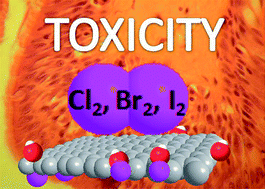Cytotoxicity of halogenated graphenes
Abstract
Graphene and its family of derivatives possess unique and remarkable physicochemical properties which make them valuable materials for applications in many areas like electronics, energy storage and biomedicine. In response to the possibility of its large-scale manufacturing as commercial products in the future, an investigation was conducted to determine the cytotoxicity of one particular family of graphene derivatives, the halogenated graphenes, for the first time. Halogenated graphenes were prepared through thermal exfoliation of graphite oxide in gaseous chlorine, bromine or iodine atmospheres to yield chlorine- (TRGO-Cl), bromine- (TRGO-Br) and iodine-doped graphene (TRGO-I) respectively. 24 h exposure of human lung carcinoma epithelial cells (A549) to the three halogenated graphenes and subsequent cell viability assessments using methylthiazolyldiphenyl-tetrazolium bromide (MTT) and water-soluble tetrazolium salt (WST-8) assays revealed that all the halogenated graphenes examined are rather cytotoxic at the concentrations tested (3.125 μg mL−1 to 200 μg mL−1) and the effects are dose-dependent, with TRGO-Cl reducing the cell viability to as low as 25.7% at the maximum concentration of 200 μg mL−1. Their levels of cytotoxicity can be arranged in the order of TRGO-Cl > TRGO-Br > TRGO-I, and it is suggested that the amount of halogen present in the graphene material is the determining factor for the observed trend. Control experiments were carried out to test for possible nanomaterial-induced interference as a consequence of reaction between the halogenated graphenes and the viability markers (MTT/WST-8 reagent) or binding of the formazan products under cell-free conditions. The data obtained eliminate the probability of significant influence by these interferents as the change in the normalized percentage of formazan formed is relatively small and thorough washings were performed prior to the viability assessments to reduce the amount of halogenated graphenes that could eventually interact with the MTT/WST-8 assays. More studies need to be carried out in the future to complement the results obtained in this initial study in an attempt to develop a better understanding of the health hazards that the halogenated graphenes pose.


 Please wait while we load your content...
Please wait while we load your content...